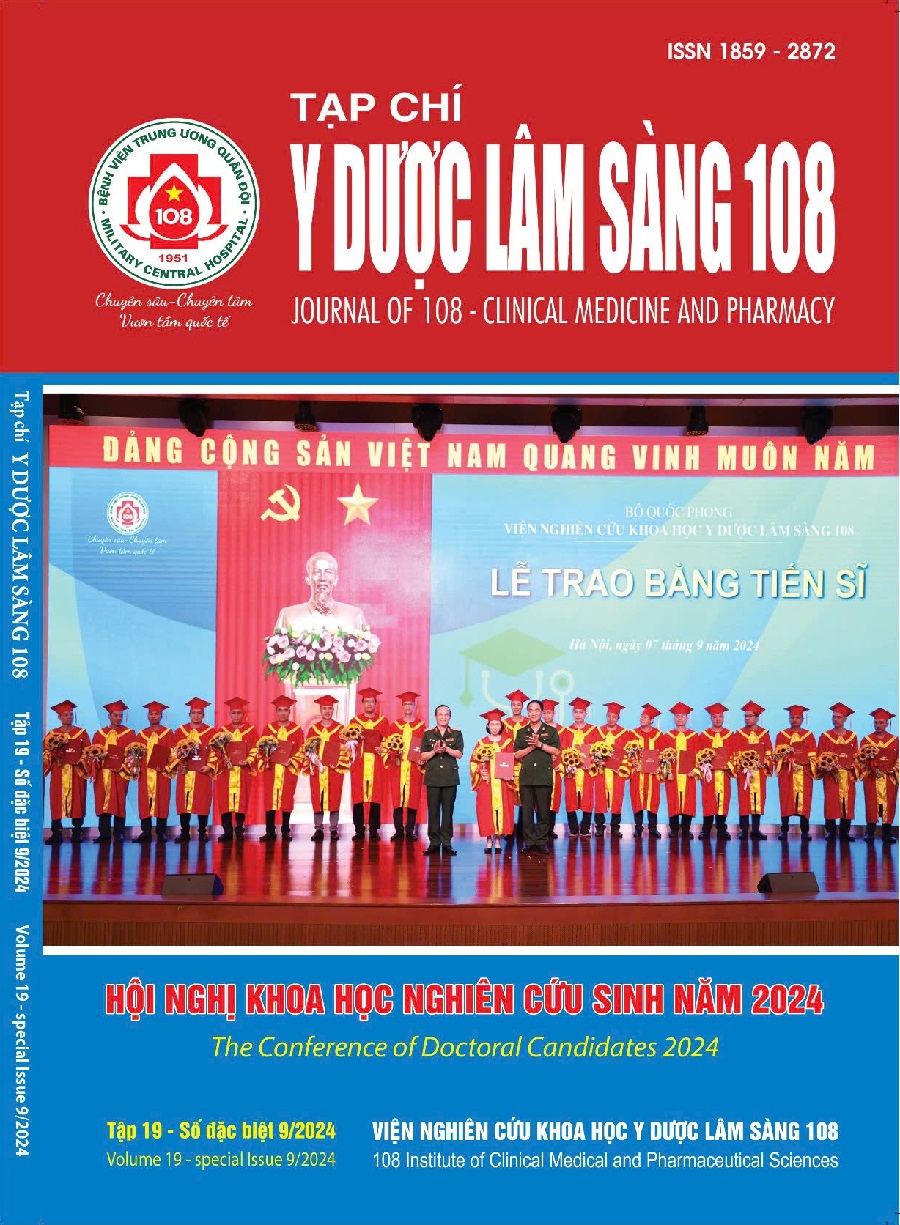The survival and associated factors of six-month survival of patients with malignant distal biliary stricture following endoscopic biliary stent procedure
Main Article Content
Keywords
Abstract
Objective: To evaluate the survival and factors related to survival over 6 months of patients with malignant biliary obstruction following endoscopic retrograde cholangiopancreatography. Subject and method: 79 patients with malignant biliary obstruction following stent placement via endoscopic retrograde cholangiopancreatography at the Department of Gastroenterology, Central Military Hospital 108 from January 2018 to March 2022. Non-controlled interventional and cross-sectional description designs, non-probability sample selection (convenience) were used. Result: Survival ≥ 6 months accounted for the highest rate (41.8%), the lowest was survival < 1 month (2.5%), the average was 187.6 ± 148.8 days. The survival ≥ 6 months was significantly reduced (p<0.05) in the groups with stage III and IV cancer; comorbidities, blood albumin < 30g/dL; cachexia; stent placement for palliative treatment; early and late complications following stent placement. Conclusion: The survival ≥ 6 months was high. Cancer stage III and IV, comorbidities, blood albumin, indication of stent placement for treatment, complications following stent placement using endoscopic retrograde cholangiopancreatography were able as factors to predict the survival ≥ 6 months of patients with malignant biliary obstruction following endoscopic retrograde cholangiopancreatography.
Article Details
References
2. Kusumaningtyas L, Makmun D, Syam AF, Setiati S. (2020) Six-month survival of patients with malignant distal biliary stricture following endoscopic biliary stent procedure and its associated factors. Acta Med Indones 52(1): 31-38.
3. Luo J, Xiao L, Wu C, Zheng Y, Zhao N (2013) The incidence and survival rate of population-based pancreatic cancer patients: Shanghai cancer registry 2004-2009. PLoS One 8(10): 76052. doi:10.1371/journal.pone.0076052.
4. Termsinsuk P, Charatcharoenwitthaya P, Pausawasdi N (2022) Development and validation of a 90-day mortality prediction model following endobiliary drainage in patients with unresectable malignant biliary obstruction. Frontiers in Oncology 12: 922386.
5. Liao WC, Angsuwatcharakon P, Isayama H, Dhir V, Devereaux B, Khor CJ et al (2017) International consensus recommendations for difficult biliary access. Gastrointest Endosc 85(2): 295-304. doi:10.1016/j.gie.2016.09.037.
6. Bô Y tế (2014) Nội soi mật tụy ngược dòng can thiệp đặt stent đường mật - tụy. Hướng dẫn quy trình kỹ thuật Nội khoa chuyên ngành Tiêu hóa, Nhà xuất bản Y học, Hà Nội, tr. 77-81.
7. Isayama H, Hamada T, Yasuda I, Itoi T, Ryozawa S, Nakai Y et al (2015) TOKYO criteria 2014 for transpapillary biliary stenting. Digestive endoscopy 27(2): 259-264.
8. Đỗ Quang Út NTT, Nguyễn Khánh Trạch (2021) Đánh giá các biến chứng của đặt stent đường mật qua nội soi mật tụy ngược dòng trong điều trị tắc mật do ung thư. Tạp chí Y Dược lâm sáng 108 16(8): 46-56.
9. Zu QQ, Zhang JX, Wang B, Ye W, Liu S, Shi HB (2019) Percutaneous transpapillary biliary stent placement for distal malignant biliary obstruction: Outcomes and survival analysis. The Turkish journal of gastroenterology : The official journal of Turkish Society of Gastroenterology 30(8): 714-721. doi:10.5152/tjg.2019.18317.
10. Nakai Y, Isayama H, Sasaki T, Sasahira N, Tsujino T, Kogure H et al (2011) Comorbidity, not age, is prognostic in patients with advanced pancreatic cancer receiving gemcitabine-based chemotherapy. Crit Rev Oncol Hematol 78(3): 252-259. doi:10.1016/j.critrevonc.2010.05.007.
11. Akirov A, Masri-Iraqi H, Atamna A, Shimon I (2020) Corrigendum to low albumin levels are associated with mortality risk in hospitalized patients. American Journal of Medicine 130(12): 1465. 11-1465.e19, Am J Med. 133(5):646. doi:10.1016/j.amjmed.2020.02.001.
 ISSN: 1859 - 2872
ISSN: 1859 - 2872
